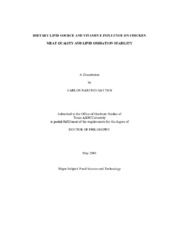| dc.description.abstract | In the poultry industry, further processed meat products have the highest share in the market, and because there is a growing demand of food products with enriched amounts of unsaturated fatty acids, the objectives of this research were to assess lipid oxidation development and quality characteristics of chicken meat as affected by dietary fat and vitamin E levels. Broilers were fed during six weeks with diets containing animal/vegetable, lard, palm kernel, soybean, conjugated linoleic acid, flaxseed, or menhaden oil. Each lipid diet was supplemented with either a control (33 or 42 mg/kg) or a supranutritional level (200-400 or 200 mg/kg) of vitamin E. Breast and thigh meat, or skin, were processed, packaged, and refrigerated as raw meat, cooked patties, or cooked sous vide meat. The results showed that the chicken meat fatty acid composition reflected those from the dietary fats. In the meat or skin there was a higher lipid oxidation susceptibility as the proportion of unsaturated fatty acids increased, shown as malonaldehyde values, particularly in the treatments with low supplemented level of vitamin E (P<0.05). The relative lipid oxidative stability of the meat decreased in consecutive order from raw, cooked sous vide, and cooked meat patties. Sous vide cooked meat developed lipid oxidation at a slow rate and showed not to be affected by nonheme iron values. Dietary fat and vitamin E level affected breast meat lightness (L* color space) values (P<0.05), but not muscle pH, Allo-Kramer shear force, or water holding capacity. In conclusion, the increment in the proportion of unsaturated fatty acids increases the susceptibility to lipid oxidation in the meat. Supranutritional supplementation levels of vitamin E are more effective at inhibiting the lipid oxidation development in chicken meat than some current levels used by the poultry industry. Neither dietary fat nor vitamin E level seems to affect the development of pale, soft, and exudative meat condition in chicken meat. | en |


